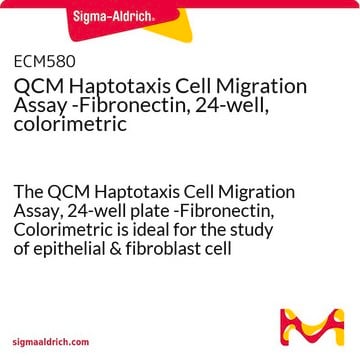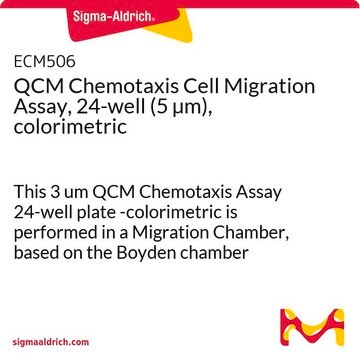ECM582
QCM Haptotaxis Cell Migration Assay -Collagen I, 24-well, colorimetric
The QCM Haptotaxis Cell Migration Assay, 24-well plate -Collagen 1, Colorimetric is ideal for the study of epithelial & fibroblast cell haptotaxis.
Autenticatiper visualizzare i prezzi riservati alla tua organizzazione & contrattuali
About This Item
Codice UNSPSC:
12352207
eCl@ss:
32161000
NACRES:
NA.84
Prodotti consigliati
Livello qualitativo
Reattività contro le specie
vertebrates
Produttore/marchio commerciale
Chemicon®
QCM
tecniche
cell based assay: suitable
Metodo di rivelazione
colorimetric
Condizioni di spedizione
wet ice
Descrizione generale
Also available: Cell Comb Scratch Assay! Get biochemical data from a scratch assay!Click Here
Introduction
The CHEMICON QCM Haptotaxis Cell Migration Assay - Collagen 1, Colorimetric is ideal for the study of epithelial and fibroblast cell haptotaxis. The quantitative nature of this assay is especially useful for large scale screening of pharmacologic agents. BSA-coated control chambers provide an appropriate migration control. The 8 μm pore size of this assay′s Boyden chambers is not appropriate for the study of lymphocyte migration.
• Each kit provides sufficient materials for the evaluation of 12 samples.
• Please refer to the product insert for assay details.
The CHEMICON QCM Haptotaxis Cell Migration Assay - Collagen 1, Colorimetric assay is intended for research use only; not for diagnostic applications.
Introduction
The CHEMICON QCM Haptotaxis Cell Migration Assay - Collagen 1, Colorimetric is ideal for the study of epithelial and fibroblast cell haptotaxis. The quantitative nature of this assay is especially useful for large scale screening of pharmacologic agents. BSA-coated control chambers provide an appropriate migration control. The 8 μm pore size of this assay′s Boyden chambers is not appropriate for the study of lymphocyte migration.
• Each kit provides sufficient materials for the evaluation of 12 samples.
• Please refer to the product insert for assay details.
The CHEMICON QCM Haptotaxis Cell Migration Assay - Collagen 1, Colorimetric assay is intended for research use only; not for diagnostic applications.
Applicazioni
Research Category
Cell Structure
Cell Structure
Confezionamento
Sufficient for analysis of 12 samples
Componenti
Collagen 1 Test Plate: (Part No. 2005690) One 24-well culture plate, containing 12 human Collagen 1 coated Boyden chambers, sufficient for the evaluation of 12 test samples.
BSA Control Plate: (Part No. 2005791) One 24-well culture plate, containing 12 BSA-coated Boyden chambers, sufficient for the evaluation of 12 controls.
Cell Stain Solution*: (Part No. 20294) One vial - 10 mL.
Extraction Buffer: (Part No. 20295) One vial - 10 mL.
24 well Stain Extraction Plate: (Part No. 2005871). One plate.
96 well Stain Quantitation Plate: (Part No. 2005870). One plate.
Swabs: (Part No. 10202) 50 each.
Forceps: (Part No. 10203) 1 pair
*Cell Stain Solution contains a small amount of crystal violet, which is toxic if swallowed or inhaled, and may cause irritation to the eyes, respiratory system, and skin. Handle with caution.
BSA Control Plate: (Part No. 2005791) One 24-well culture plate, containing 12 BSA-coated Boyden chambers, sufficient for the evaluation of 12 controls.
Cell Stain Solution*: (Part No. 20294) One vial - 10 mL.
Extraction Buffer: (Part No. 20295) One vial - 10 mL.
24 well Stain Extraction Plate: (Part No. 2005871). One plate.
96 well Stain Quantitation Plate: (Part No. 2005870). One plate.
Swabs: (Part No. 10202) 50 each.
Forceps: (Part No. 10203) 1 pair
*Cell Stain Solution contains a small amount of crystal violet, which is toxic if swallowed or inhaled, and may cause irritation to the eyes, respiratory system, and skin. Handle with caution.
Linkage
Replaces: ECM502
Stoccaggio e stabilità
Store at 4°C for up to one year after date of purchase.
Note legali
Accutase is a registered trademark of Innovative Cell Technologies, Inc.
CHEMICON is a registered trademark of Merck KGaA, Darmstadt, Germany
Esclusione di responsabilità
Unless otherwise stated in our catalog or other company documentation accompanying the product(s), our products are intended for research use only and are not to be used for any other purpose, which includes but is not limited to, unauthorized commercial uses, in vitro diagnostic uses, ex vivo or in vivo therapeutic uses or any type of consumption or application to humans or animals.
Avvertenze
Danger
Indicazioni di pericolo
Consigli di prudenza
Classi di pericolo
Eye Irrit. 2 - Flam. Liq. 2
Codice della classe di stoccaggio
3 - Flammable liquids
Classe di pericolosità dell'acqua (WGK)
WGK 3
Certificati d'analisi (COA)
Cerca il Certificati d'analisi (COA) digitando il numero di lotto/batch corrispondente. I numeri di lotto o di batch sono stampati sull'etichetta dei prodotti dopo la parola ‘Lotto’ o ‘Batch’.
Possiedi già questo prodotto?
I documenti relativi ai prodotti acquistati recentemente sono disponibili nell’Archivio dei documenti.
Mariel Maldonado et al.
American journal of respiratory cell and molecular biology, 59(1), 77-86 (2018-01-27)
Idiopathic pulmonary fibrosis (IPF) is a chronic and progressive aging-associated disease of unknown etiology. A growing body of evidence indicates that aberrant activated alveolar epithelial cells induce the expansion and activation of the fibroblast population, leading to the destruction of
Nilgun Tasdemir et al.
Scientific reports, 10(1), 11487-11487 (2020-07-15)
Invasive lobular carcinoma (ILC) is a histological subtype of breast cancer with distinct molecular and clinical features from the more common subtype invasive ductal carcinoma (IDC). ILC cells exhibit anchorage-independent growth in ultra-low attachment (ULA) suspension cultures, which is largely
Il team dei nostri ricercatori vanta grande esperienza in tutte le aree della ricerca quali Life Science, scienza dei materiali, sintesi chimica, cromatografia, discipline analitiche, ecc..
Contatta l'Assistenza Tecnica.










